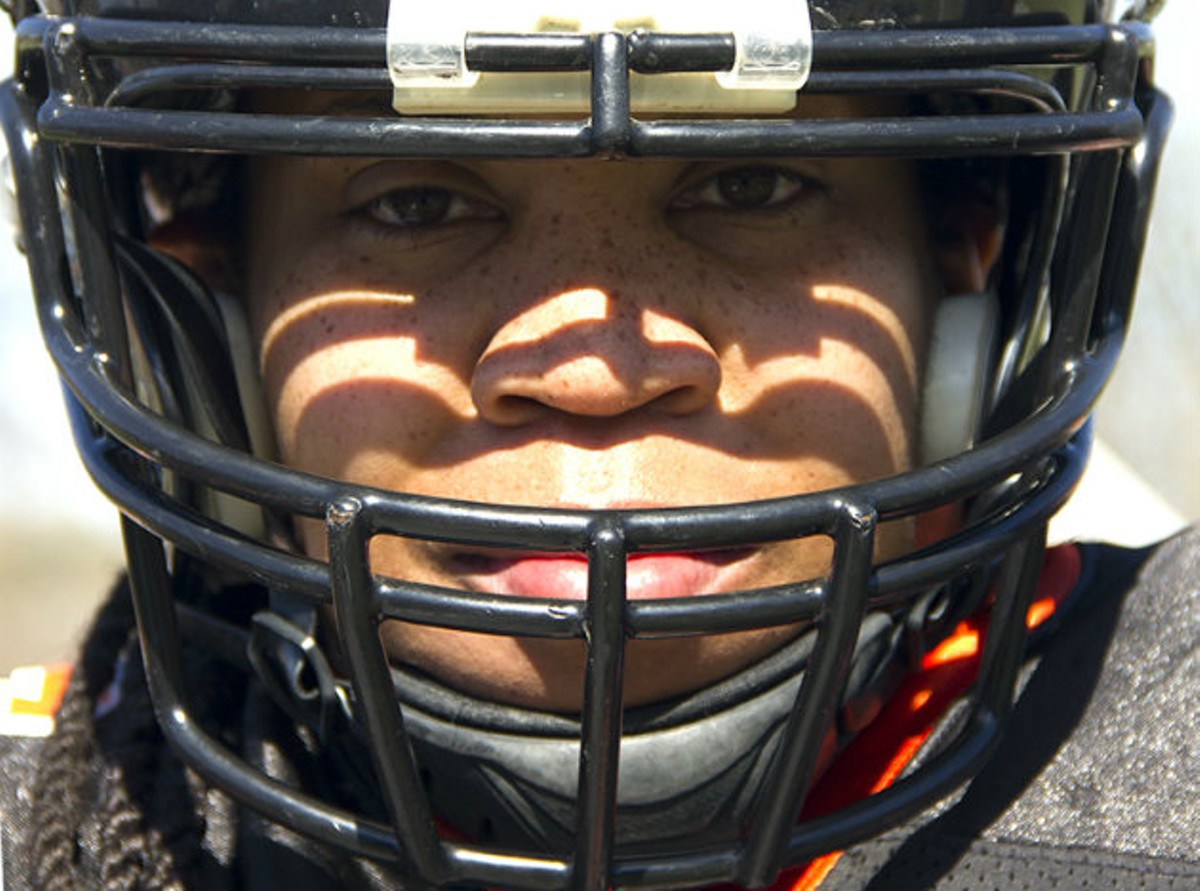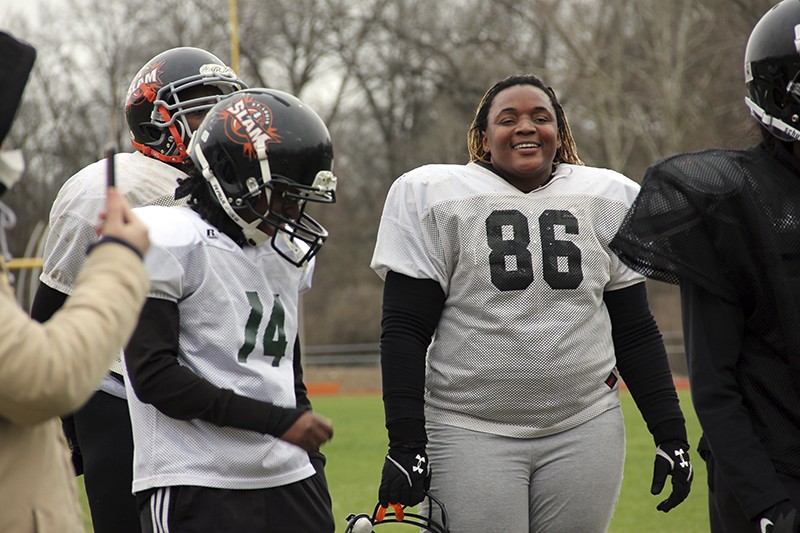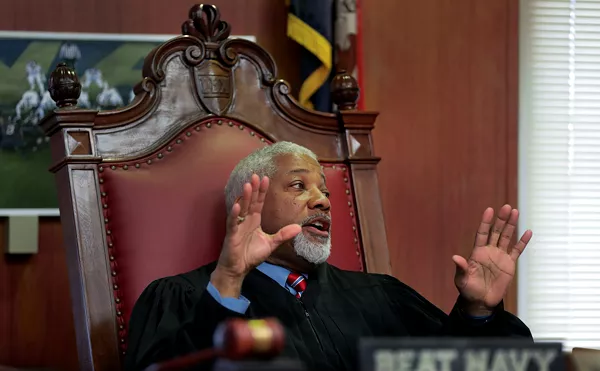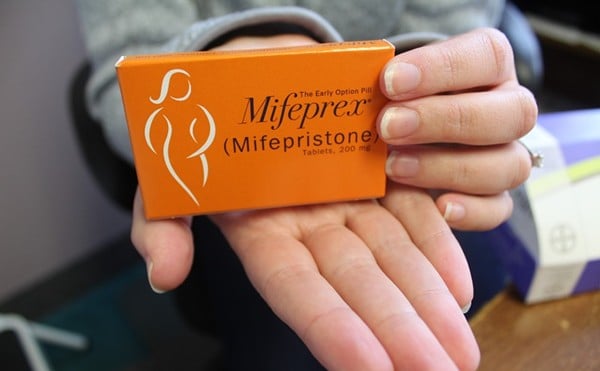Myrt Davis has waited seven months to deck someone, to literally pummel them into the ground.
"Oh my god, it's amazing. Everybody looks forward to the first day in pads," Davis says. She tugs at the straps of the gleaming black helmet in her hands. "And today is it."
A 42-year-old defensive tackle for St. Louis' powerhouse women's football team, Davis has the muscled arms and legs necessary to propel a 215-pound body into the scrum of the opposing team's largest players. For weeks, she and the rest of the 2017 roster have sweated in the weight room and run through drills wearing sweatpants and t-shirts. But today is Hitting Day. Here, on a high school field in Ladue, is where the year's real football begins.
Davis fits the bulky helmet over her short silver hair, and suddenly the eyes behind the facemask look like they've been carved from granite. She trots onto the field, joining the dozen or so hollering figures in black helmets and pads.
Most of her teammates are in their mid-to-late 20s and 30s, but some rookies are just a few years out of high school even as some, like Davis, have already celebrated their fortieth birthdays. They are mothers, sisters, daughters, college students, managers, teachers, nurses and public servants. They are the St. Louis Slam: a full-contact and (nearly) all-female football team that's spent the last fifteen years quietly excelling in the shadow of the region's college football teams — and, until last year, the NFL's Rams.
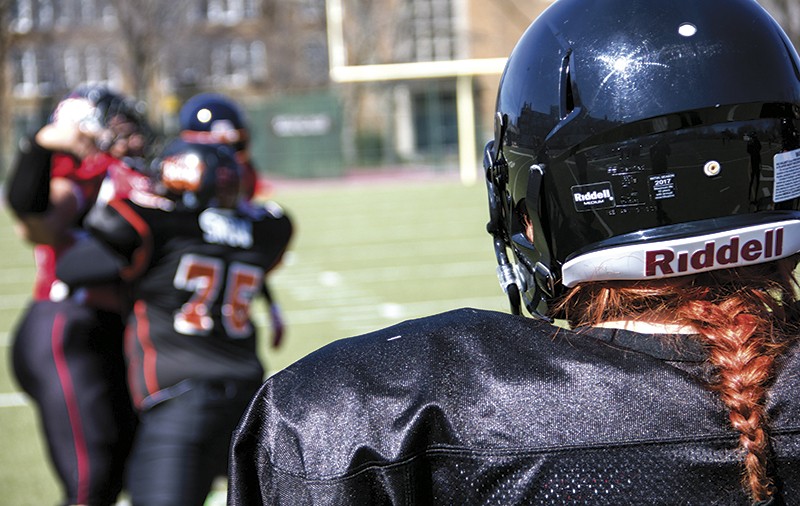
To be clear, they belie many of the stereotypes you may have about football, and women's football in particular. The Slam do not play flag football, there is no lingerie on the field and no one is paid. But it is winning, not money, that's attracted the largest incoming rookie class in the team's history, adding nineteen players to a roster that's now 42 strong. Last season, the Slam obliterated its two playoff opponents by a combined score of 97-6. In the championship game, the team wrecked the previously undefeated Tampa Bay Inferno 38-7. Now, the team has a chance to defend its title as the Division 2 champions of the Women's Football Alliance.
The time for relishing past victories is over. The team's returning veterans want another ring, and the rookies want their own shot at glory. The Sunday practice is less than two months removed from the first real game of the 2017 season, scheduled for April 1. And so on this gray Sunday in February, the players are finally going to hit each other. Not just once, and not softly — but again, and again, and again. Until they get it right. Until they can handle it. Until they love the hits, like Davis and the other vets.
"It just doesn't feel like football until that contact starts," says Davis, grinning behind her face mask. She adds, "Honestly, it's like putting on a comfortable pair of old shoes."
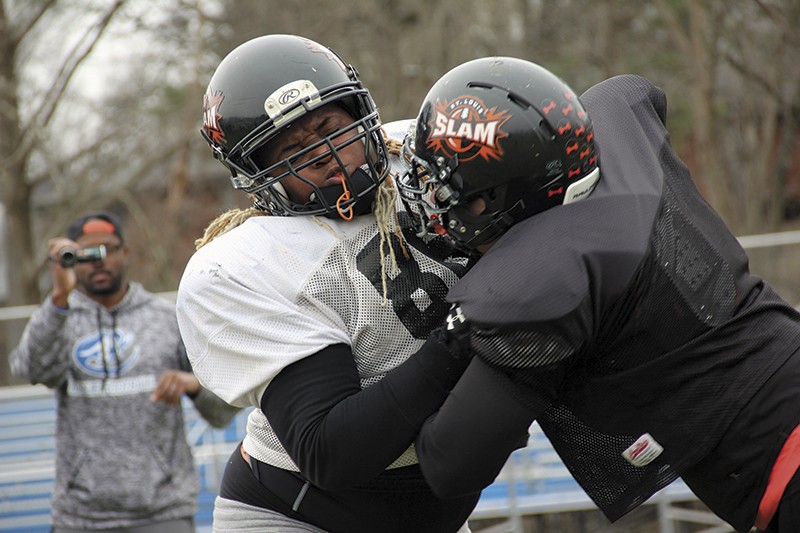
Taylor Hay is on the field Sunday, though she's left her pads and helmet at home. The team's 4'10", 140-pound running back has strep throat, but instead of bed rest and chicken soup, she's out here in the 40-degree weather, wrapped in a jacket and shouting at her teammates through a white surgical mask.
The practice's first contact drill involves two players, and is designed to test both tackling form and, subsequently, the ability to withstand the force of someone leaping through the air and smashing a shoulder into your guts. The veterans advise the rookies, "Trust the pads."
One player stands motionless in front of a landing area made of padded blue cylinders. The other, the tackler, takes a few steps to gain speed, plants one foot and then drives her corresponding shoulder into the first player's chest, aiming her blow just beneath her opponent's chest-pads — and sending both women flying backwards on the padding.
Or, at least, that's how it's supposed to work. A few minutes into the drill, a pair of players collide listlessly, more face-to-face than shoulder-to-chest. Hay, who is entering her eighth season with the Slam, takes note of the sloppy hit. Vocally.

"Y'all rubbing titties together, c'mon!" she shouts. Hay kicks the jostled pads straight as the next players take their positions. When she's satisfied, she barks the two-word signal to begin from behind her surgical mask: "Set; hit!"
The team's bespectacled head coach and co-owner, Quincy Davis, observes the action and offers critiques after each run. A former cornerback who played Division III football at Washington University, Davis joined the team in 2006 as an assistant coach. A decade later, with two championships under his belt, Davis pretty much runs the show, though he relies on assistance from the team's former head coach, Rodney Lacy, and a rotating staff of position-specific instructors. As with the players, none of the coaches draws a salary.
Davis takes Hay's place behind the row of blue pads and checks the camcorder trained on the scene before him. He gives the signal. "Set; hit!"
Chelsea Clay, one of the lighter, more agile team members (she plays both wide receiver on offense and several positions on defense), crashes a teammate into the pads and winds up in a tangled heap. "Good, good," Davis says.
The coach then gestures for the group's attention. "Rookies, raise your hands," he says. "Let's make sure we are stomping that foot before contact. Other thing, don't aim for her chest, alright? We want to hit her spinal cord, we want to run through her."
Davis calls for a player to act as a prop, and he pantomimes in slow-motion, demonstrating proper hand placement, the angle of the shoulder, the position of the head at the moment of impact.
"Our initial touching her is not what's going to get her down," he continues. "We hit her, we stop her momentum, and then we send her back to where she came from."

He motions the next pair of players to the pads. "Set; hit!"
It takes time and repetition — so many repetitions — to get things right. "Way too tall, baby, way too tall," Davis tells one player as she's helped off the padding. "You're going to miss a bunch of tackles trying to hit her in the face, alright?"
As jolting as this drill is, it's only a prelude to a true one-on-one matchup, what the coaches and players call "battle." Two players meet each other face to face, close enough that they can almost knock helmets. Both settle into a crouch called a "three-point stance." Each raises her hips, anchors one hand to the ground and holds the other close to her body, elbow tight to the ribs and a hand up, ready to strike. On the mark of "set; hit," the two players rocket at each other with violent intent. The goal of battle is simple: Push your opponent backwards. Don't get pushed.
Davis isn't the sort of coach who makes every statement a shout, but he puts some steel into his voice as he introduces the drill to the group. His audience has now swelled to include the two-dozen players who have just returned from their stint in the weight room.
"This is me against you, this is how good am I with my hands, how good am I with my first step, just coming right at you. Veterans," the coach deadpans at the older players, "raise your hand if you ever got your ass handed to you in this drill." Amid laughter, all but the rookies raise their hands.
Set in their stances, the players take turns hurling themselves into the calamitous embrace of their fellow teammates. It's not difficult to figure out which players have done this before and which are still getting comfortable moving with fifteen pounds of pads and viewing the world through the narrow window of their helmet's face mask.
Hay cheers from a distance. In place of brute strength, the dimunitive former Missouri Baptist University soccer player relies on her quickness to elude tacklers on the field.
"In that drill, I literally lose every single time," she says.
As for the rookies, Hay liked what she saw. "Overall, I'm proud of them," she says. "It's hard. Tomorrow they'll be sore. But they didn't give up."
At the conclusion of the day's practice, Davis sends the whole team on a series of sprints to simulate first, second, third and fourth down. It leaves most of the players doubled over and groaning. They trudge on burning muscles into a ragged circle around their head coach for the practice's final announcements.
"I say this often, but football is a game of shit not being ideal," Davis begins. "For some of you, this was your first time hitting. But now that you've done it, did anybody die? I keep asking y'all, go fast, go hard, make some mistakes — the faster you make mistakes, the faster we can fix them, and you can get on to being a better player. Fair enough?"
Through their exhaustion, the players respond, "Yes, coach."
At practice one week later, the team convenes to watch its mistakes on film. In a second-floor classroom inside the pool building of Horton Watkins High School in Ladue, one-half of the team's members stretch their sore limbs as coach Davis flashes through video clips from the previous week's drills. A few players slide to the floor and massage ice packs into their knees. (The air is pungent with an odor Myrt Davis later describes, quite fairly, as "vinegar and Fritos.")
Coach Davis notes the clumsy footwork and missed blocks, but these are just matters of technique. The players must also memorize the specific code words and gestures that their coaches deploy from the sidelines to tweak the tactics on the field. Those signals will be tested next week, when the team will assemble for what has become an annual tradition: a scrimmage with Kentucky-based Derby City Dynamite. It will be the first time the Slam's rookies get to hit someone wearing a different uniform than their own.
But there is more to football than its violence and aggression. For players, the sport requires a kind of fanatical trust, a willingness to execute a coach's orders. Although the quarterbacks, wide receivers and running backs attract most of the glory — after all, they actually get to touch the ball — the reality is that every play, both offense and defense, is a carefully choreographed dance involving all eleven players. That requires physical precision, but also devotion — a kind of duty — to serving in a role, no matter how overlooked or unheralded.
And that remains true whether the players underneath the pads are men or women. After the tape-watching session, assistant coach Rodney Lacy heads to a nearby sports bar and grill, accompanied by Taylor Hay (now recovered from her strep throat), Chelsea Clay, linebacker Tiffany Pugh and cornerbacks Raven Williams and Brooklynn Bastain. Robyn Morrow, one of just three players still active from Slam's inaugural 2003 roster, holds court at the other end of the table.
Yes, they confirm, they do get dumb questions lobbed at them every so often. People think the only outlet for women's tackle football is the Lingerie Football League, which outfits players in underwear and "revealing" padding that offers lots of skin and little actual protection.
The most frustrating question for the Slam players, however, is also the most common.
"'Oh, we have a women's team in St. Louis?'" grunts Pugh, mimicking an exaggerated bro-talk. "It's just annoying that, yes, we actually have a team. I mean, our name's on the wall at Dave and Buster's! And we got rings!"
Both on and off the field, the Slam's fortunes are borne on the backs of the players. Individual team members are expected to raise $850 this season through ticket sales or booking sponsorships. If there's anything their fundraising doesn't cover, they are personally on the hook. Rookies might have to spend up to $500 for equipment and protective gear.
The team also requires a serious time commitment. Outside of the fundraising and the thrice-weekly practices, players make public appearances to boost interest for the coming season.
"The men in the NFL, they play and that's their job," Hay notes. "We literally have to be adults during the day, then study and go to practice, do everything correctly, and then wake up and do everything all over again. And not get paid."
And though their opponents might lack the sheer size and speed present on professional men's teams, that doesn't make the sport any safer. In sports that require similar movements, like basketball, volleyball and soccer, research has found that, compared to men, women are as much as eight times more likely to tear their anterior cruciate ligament — a devastating knee injury that sometimes never heals completely and can end an athlete's career in an instant.
In existing medical literature, however, women's tackle football simply doesn't exist. While the NFL's concussion crisis has attracted serious research and massive public interest, the world of women's tackle football lacks basic data. We don't know, for instance, the number of women who tore their ACL last season. Or the number of sprained ankles. We don't know how many were diagnosed with concussions.
At least one person, a master's student and former Women's Football Alliance player in Wisconsin, is currently collecting concussion data on women's tackle football, but the present gap in knowledge leaves sports medicine experts like Dr. Matthew Matava to make educated guesses based on studies of other sports.
"If I had to predict, I think the injuries are going to parallel the men's game," says Matava, who served as team physician for the St. Louis Rams prior to the team's departure. He's also treated thousands of athletes as lead doctor for Washington University's athletic department. (Of course, the university only maintains a men's football team.)
"Certainly, they're going to be at risk for having a concussion, just because of the nature of the sport," he says. "These are contact and collision sports. And because of that you're always going to have a certain risk of injury. No matter how many training programs you put into place, no matter how many rule changes you have, there's still going to be risks for injury."
For Slam players, experiences with injuries vary. Minor sprains are common, along with bruises, aches and cuts. But every so often, catastrophic injuries do occur.
Back at the sports bar after practice, Robyn Morrow turns her arm in the light, revealing a series of tattoos that trace the phases of the moon. The ink covers the scar tissue where a broken bone punctured the skin from the inside. The recovery took a year and involved multiple surgeries, but she was eventually able to return for the 2016 championship run.
"I was crying," Morrow says, describing the collision that ended her season. A teammate had accidentally crashed into her arm, helmet-first. It was her first serious injury of her lengthy football career, a time period in which she also counts three concussions. She adds, "And I wasn't crying because it was broken, but because I couldn't play."
It's not just the stress on their bodies; balancing both the team and a career can be a real challenge. Williams, now in her third year with the Slam, nearly missed the championship game in Pittsburgh last year because her bosses with the St. Louis County Police Department wouldn't give her time off from its training academy. The team sent letters to the chief, begging for an exception. No dice. Ultimately, Williams flew to Pittsburgh the day of the game, changed clothes in a taxi and made it to the field an hour before kickoff.
"We're constantly proving ourselves," Williams says, "to men, to the world..."
Hay interrupts through a mouthful of burger, "And to women! Girls don't have to think, 'There are only certain games designed for me because I'm a girl.'"
Brooklynn Bastain wanted to play football so badly that she quit her job last year as a traveling nurse in Kansas City; it was keeping her from too many practices.For Bastain, who ran track at Saint Louis University, the Slam is family — and not just in the figurative way that people tend to use when talking about sports. By the time Bastain joined the team in 2015, her mother, Antonnia Washington, had already put in five years on the Slam's offensive line.
"My baby sister is ten years old and thinks nothing of her mom and her sister playing football," Bastain says. "It's just normal."
Listening as his players dish back and forth at the table, coach Lacy cuts in with an anecdote of his own. Along with his coaching work with the Slam, Lacy works with the football program at Webster Groves High School.
"I used to use film of the women to teach the high school boys how to run plays," says Lacy, a note of amusement creeping into his voice. "I didn't tell them who it was, I'd just say, 'Hey, watch this play.' Now, you would see the hair sometimes, but some boys have long hair. Other than that, you'd just think they're running the play a little bit slower."
When Lacy would reveal that the play was being run by women, the teenaged boys laughed it off as a joke — at least, until the coach drew their attention to women in pads on the sideline.
"They wouldn't believe me," Lacy says, laughing. "Unless you pointed it out to them, they would never figure it out."
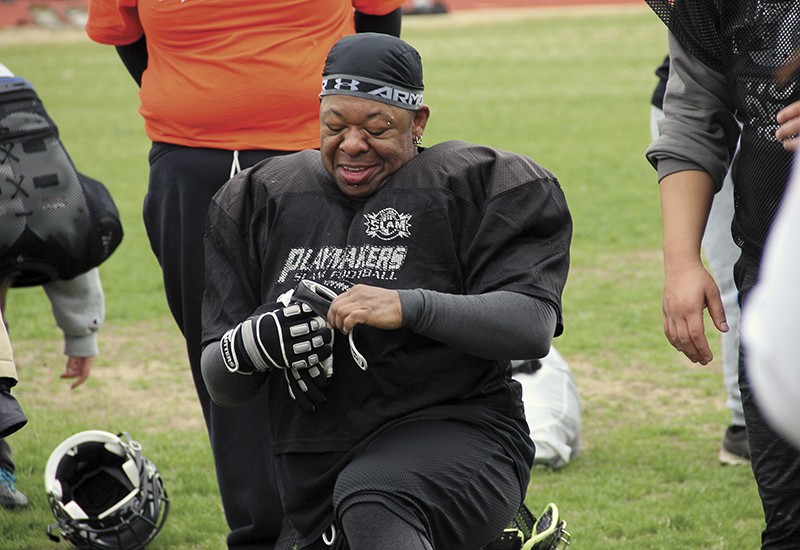
Three decades ago, Juan Snow had dreams of playing football. These days, the other Slam players call the 49-year-old "Papa" or "Old Head," but at Snow's Catholic high school in the early '80s, the school football team might as well have been located on Mars.
At the time, coaches wrote Snow off as "just a girl." "You could be good enough to make the team, but I won't let you try out. You won't play for me," the high school coach told Snow.
"But I knew my body could handle it," Snow says now. "I'm a workhorse."
Snow went on to play women's high school soccer and collegiate softball at the University of Missouri-St. Louis. It would take another decade for football to find its way back into Snow's life. Along with Morrow and Myrt Davis, Snow was an avid participant in a flag football league that convened in Forest Park.
It was from those flag football teams that the seeds of the Slam were planted. Organized by the flag football league's coaches, the Slam's first roster was stocked with female athletes searching for an outlet for their skills and competitive passion. The team debuted in the 2003 season of the National Women's Football Alliance.
Those first few seasons were rough, and not just in terms of the team's record. The coaching staff was inexperienced, Snow says, and it wasn't until Lacy and Davis took over the coaching duties that the team buckled down into its current grueling training schedule — and began piling up the wins. In 2009, the team notched its first championship victory in the Women's Football Alliance.
Much has changed since those first seasons. Three years ago, Snow made the decision to begin transitioning, and now identifies as a man — although, with the support of the team, continues to play in the women's league. While he's still a force on the offensive line, Snow now stalks the field with a pronounced gait, a kind of cowboy swagger that's developed over years.
"I have a high tolerance for pain," he says. "My surgeon and my primary doctor say there's no way I should still be physically able to play, and there's no way I should still be able to walk the way I walk with all my injuries."
Diagnosed with a degenerative joint disease, Snow gets through practices and games with a regimen of cortisol injections and painkillers that wouldn't be out of place in an NFL locker room. Snow is due for two shoulder replacements and a knee surgery to repair a torn meniscus.
Two months ago, Snow's doctors sat him down for a talk that was long coming. If you don't stop playing, they said, there won't be enough bone left on your shoulders to anchor the rebuilt joints. And so Snow finally relented.
"I almost was a punk and started crying," he says. "But I knew it was time."
The Saturday scrimmage against the Derby City Dynamite doesn't only mark the first scrimmage of Snow's final year on the Slam. It's also the last year for Robyn Morrow, who befriended Snow on a St. Louis basketball court when they were thirteen years old.
Toward the end of the scrimmage — a slobberknocker that features the Derby City players giving the Slam's roster everything they can handle — Morrow plops down on a bench next to Myrt Davis, the third remaining member of the Slam's inaugural season.

"How you feeling Myrt?" Morrow asks.
"Old, but good," Davis responds. She's less than convincing. Her face is twisted from the pain emanating from her back. It feels, she says, "like an ice pick."
Davis tries some yoga poses, stretches her back and lifting each leg in sequence. Yup, there's definitely something tweaked back there.
"I'm pretty sure this is it, my last season," Davis says.
One more grueling, eight-game, four-month ordeal of battered knees and bruised ribs. Despite all that, though, she says the last season is worth it. After all, it will be chance to repeat as champions — and for Davis, that would be the perfect to end to a journey that started when she was a little girl at her father's knee, watching the Chicago Bears on TV.
"We used to watch the NFL every weekend, when I was little," she recalls. "I'd say, 'I want play football.' And he'd say 'Oh honey, there's no football for girls.'"
The contradiction didn't sit well in Davis' young mind. "It was weird for me," she says. "My dad was a firefighter, and he was always saying, 'Do whatever your dreams are, go for it.' It was tough to hear I couldn't do something because it wasn't available to girls."
That's not the case anymore, and now as players like Davis get ready to let go of their football pads, a new crop of rookies and young players are ready to represent the black and orange. They've trained for it, hurt for it and hit for it, over and over and over. And now both newbies and veterans have a full season to play and a championship to win. "Here it is, fifteen years later," Davis says, waving at the players on the field.
All those years ago, it was Davis who scored the team's first-ever touchdown in its first-ever game. Now, two championships later, and in defiance of restrictions once thought perfectly natural, the air still crashes with the sound of women throwing their shoulders into chest pads.
The play Davis is watching ends with a collision, a pile of bodies, then mingled shouts of pride and pain. It's a familiar sound.
"Fifteen years..." Davis says again. "I hope it goes on for a long, long time."
On April 1, the Slam notched its first win of the 2017 season, beating the Indy Crash on the road 31-6. The Slam's first home game is is set for April 8 at the Lindenwood University-Belleville Campus. For more info, visit stlslamfootball.com.

